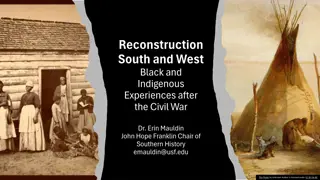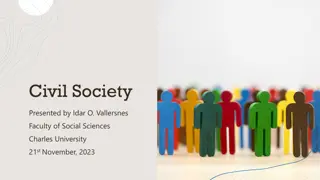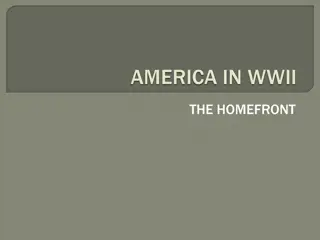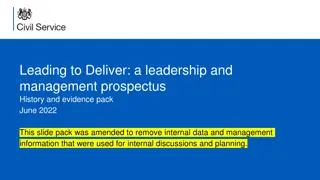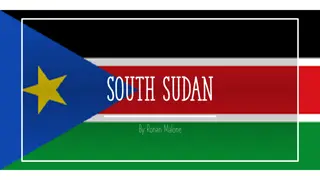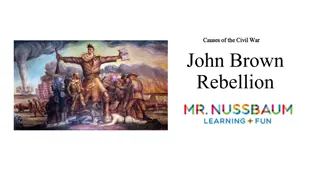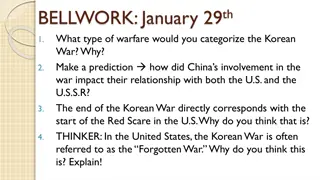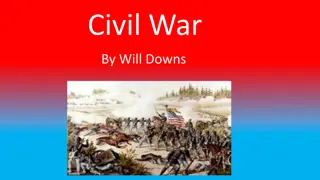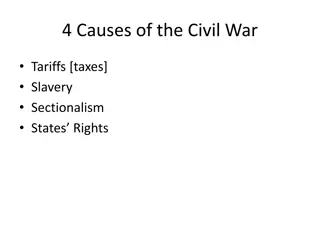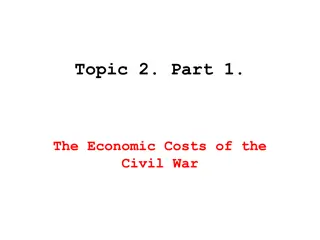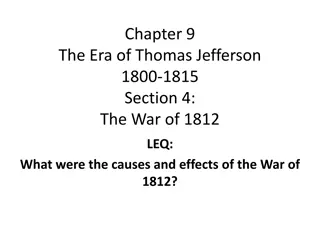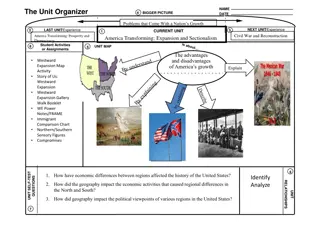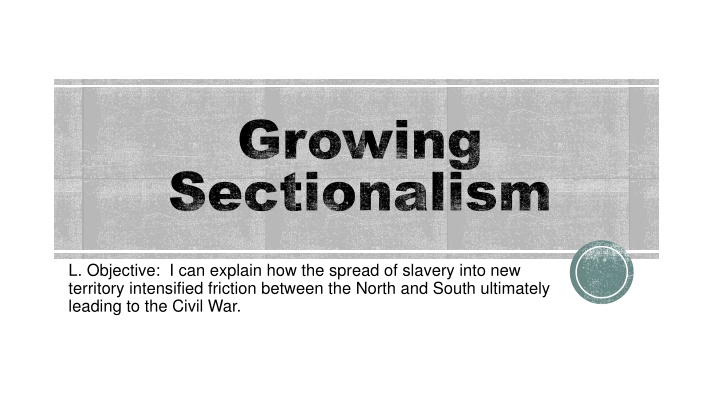
Intensifying Sectional Friction: Causes of Civil War
Explore how the spread of slavery into new territories heightened tensions between the North and South, leading to the Civil War. Discover the impact of compromises, such as the Missouri Compromise and the Compromise of 1850, on the slavery issue. Learn about factors like the Fugitive Slave Act and the Underground Railroad that fueled northern resistance. Uncover the role of events like the California Gold Rush and the Kansas-Nebraska Act in deepening the divide between the regions.
Download Presentation

Please find below an Image/Link to download the presentation.
The content on the website is provided AS IS for your information and personal use only. It may not be sold, licensed, or shared on other websites without obtaining consent from the author. If you encounter any issues during the download, it is possible that the publisher has removed the file from their server.
You are allowed to download the files provided on this website for personal or commercial use, subject to the condition that they are used lawfully. All files are the property of their respective owners.
The content on the website is provided AS IS for your information and personal use only. It may not be sold, licensed, or shared on other websites without obtaining consent from the author.
E N D
Presentation Transcript
Growing Sectionalism L. Objective: I can explain how the spread of slavery into new territory intensified friction between the North and South ultimately leading to the Civil War.
A Search for Compromise Land acquired from Mexican War opened up new opportunities for settlers but also raised the issue of slavery s expansion. California Gold Rush Gold discovered at Sutter s Mill in 1848 Over 80,000 Forty-niners arrived in California In 1849, California applied for statehood as a free state Compromise of 1850 California admitted as a free state Slavery in remainder of the territory would be decided by people Popular sovereignty government based on the consent of the people No interference in the slave trade Stronger Fugitive Slave Act
What previous compromise had been used to determine slavery in the new territories? Does this new compromise change the agreement of the Missouri Compromise? Why or why not?
Northern Resistance The Fugitive Slave Act increased northern resistance Any African American could be accused of being a run away and captured African Americans could not testify or call witnesses A sworn statement or testimony was that court required to prove a person was a run away slave Court received $10 if they ruled for slave catchers and only $5 if they ruled for African Americans Underground Railroad continued to help over 3,300 slaves escape Uncle Tom s Cabin written in 1852 by Harriet Beecher Stowe Changed perceptions of slavery Added to sectional division in country
Compromise leads to Bloodshed Oregon settlement and California Gold Rush showed need for transcontinental RR Choice of the starting point and route added to the division of the country Senator Stephen Douglas (IL) supported the northern route through Chicago Kansas Nebraska Act 1854 Divide the Unorganized Territory into the Nebraska & Kansas territories Repeal Missouri Compromise to allow slavery into the new territories Popular sovereignty would decide the slavery issue in new territories
Bell Question #19 Do you think that the Civil War was inevitable? Explain your thinking.
Bleeding Kansas 1856 Kansas Territory became the 1st battle ground over extension of slavery Pro-slavery supporters from Missouri clashed with anti-slavery settlers in territorial elections 200 people died and $2 million property destroyed Kansas would remain a territory until Civil War
Dred Scott decision 1857 Dred Scott sued for his freedom based on having lived in free territory Supreme Court decision Scott was not a citizen and therefore could not sue in court Ruled the Missouri Compromise was illegal Congress could not prohibit slavery in territories
John Browns Raid 1859 Radical abolitionist who believed in the violent overthrow of the slavery system During the Bleeding Kansas conflicts, Brown and his sons led attacks on pro-slavery residents He tried to start a slave rebellion in northern Virginia by seizing the federal arsenal in Harpers Ferry Quickly surrounded by militia commanded by Col. Robert E. Lee, ten of his followers were killed, and Brown himself was wounded and captured Brown was tried, convicted of treason, and hanged Turning point for the South
Emergence of Lincoln Ran for Senate in 1856 against Douglas. Unsuccessful but gained national attention. Lincoln Believed slavery was morally wrong Opposed spread of slavery into territories Not an abolitionist and affirmed South s right to have slaves A house divided against itself cannot stand. I believe this government cannot endure, permanently half slave and half free. I do not expect the Union to be dissolved I do not expect the house to fall but I do expect it will cease to be divided. It will become all one thing, or all the other. 1858
Election of 1860 Candidates Republican: Lincoln N. Democrat: Douglas S. Democrat: Breckenridge Constitutional Union: Bell
Election results Lincoln won the popular vote (40%) and the electoral vote (59%) despite not being on any ballots in the south Impact Southern states secede from the Union South Carolina 1st in February 1861

![❤[PDF]⚡ Civil War Talks: Further Reminiscences of George S. Bernard and His Fel](/thumb/20551/pdf-civil-war-talks-further-reminiscences-of-george-s-bernard-and-his-fel.jpg)
